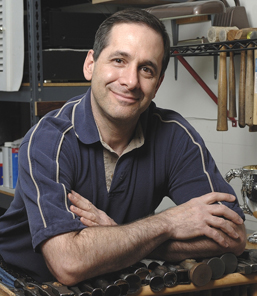
The Modern Butlers’ Journal
April 2017
In its 13th year of publication
International Institute of Modern Butlers
Teaching Right Mindset, People Skills, & Superior-service Expertise
Message from the Chairman

The MBJ was not called such without reason—it has the same dry writing style as the WSJ, and is for professionals who do not mind wading through lines and lines of text with few pictures and no cartoons, because they are interested in information first, and entertainment second. So dear readership, you may find this issue of interest, especially the recently introduced column, The Butlers Speak, where your peers provide their views on various elements of our profession. This month, the subject is something that we have all taken a keen interest in at least once in our careers—and which was probably the cause for some sleepless nights and much relief when we met with success—the job search!
Butlers in the Media
We have been hearing about robot butlers for many years, and we have been beating the drum for close to two decades about the taking-over of jobs by robots. An interesting article was posted on LinkedIn that covers the last five jobs that robots will be able to take over; while none of those listed are the butler, they each have the kind of qualities that butlers need to possess. The author does have some good ideas about how to deal with this rapid elbowing-out of humans from the work force.
A one-click booking phone app called Taxi Butler; ‘butler service’ is being offered to rich fashionistas in China, whereby clothes are ordered online, a “butler” delivers them, waits while they try them on and decide whether to keep them or send them back.
The logic, when reduced to the basic ideas being considered, could be stated as “butler = software,” “butler = delivery man.” There used to be a time such logic was considered psychotic, but today, it is tolerated as standard (disingenuous or hyperbolic) marketing.
Butler positions were noted as being advertized in Craig’s List in New York as well as Gumtree.com in South Africa. See the Butlers Speak below, which touches on the inadvisability for candidate and employer alike of advertising on such venues.
The owners of an old and grand property in England, where the butler died when he was crushed by an elevator, have been fined and this tragic case closed. The question that was not answered until now, is why the butler was in the elevator in the first place. It apparently had malfunctioned and some luggage had become trapped. The butler, who was on his way to serve tea, stepped in to free the luggage, and the elevator fell on him. An earlier malfunction had not resulted in a qualified elevator technician being brought in. Had this been done, the proper slack-rope detector would have been installed and the poor butler would be with us today. Takeaway? Bring in qualified technicians to deal with malfunctioning equipment, especially when dealing with machinery that can be lethal if not operating properly. And if tempted to step in and sort out something like jammed luggage, evaluate the scene for possible dangers and take action that does not put self or others at risk—or wait for the experts.
Placement
Estates Manager & PA for all North American properties and business interests of principal, who is out of the country half the year. Single male preferred who may or may not have experience, but has the basic organizational and management skills and is sufficiently self-determined to not need supervision once he has been shown the ropes (by the principal). Salary DOE. If interested, please send resume.
Letters to the Editor

“I’m currently studying International Hospitality management at Oxford Brookes University, UK, and am looking for a years placement in butlering. I am very keen on breaking in to the private household sector but lack experience to do so as I have yet to work in a private household. I have however had a wide range of experience in the hospitality industry.”
Ed: Thanks for reaching out and I am glad you are looking at private service as a career. An internship is something that follows training on a subject. So you would need to do a butler course, whether in a school or online, such as the one we offer, in order then, to do an internship. And also, in effect, to have a better chance of being hired with zero private-service experience. You might be able to fit in the 300-400 hours of study needed to graduate the online course while completing your studies at Oxford Brookes U. Or perhaps take a bricks-and-mortar course during summer vacation or after graduating from OBU. Anything is possible in this world—that you could be hired with no private-service experience, but rather than rely on a remoter possibility, we recommend putting in the necessary training for a more certain outcome.
Book Review of Serving the Wealthy
Sections on Tea (Volume 1, pages 248-251 and Volume 2, page 317)
What a Full Afternoon Tea Means (Part 2 of 3)
by Gretchen dePillis

To expand on the points on tea covered in Mr. Ferry’s books, Serving the Wealthy Parts I & II, I thought some history would prove interesting.
Tea was introduced to Britain via Dutch ships in the 1650’s. Initially served in coffee houses, the British found the beverage to be intriguing, but also viewed it with skepticism. Coffee, after all, had only reached Britain twenty years earlier. Tea was “marketed” as an alternative to ale, the common beverage of the day, as stimulating, yet not alcoholic. Soon, tea became the solution to everything from relieving a bad headache to a miserable day.
Around the 1660’s, tea was popularized by Catherine of Braganza, the wife of King Charles II, who had brought some with her from her native Portugal. Soon, it became “the” beverage to drink after meals. Eventually, the custom was established that after dinner, women would drink the hot beverage in one room, whilst the men discussed matters of the world over port in another room. In the 1690’s, William Congreve wrote that the men thought the women were intertwined with “tea and scandal”.

As meal times changed, the British perfected the art of using a full tea as a time to discuss matters of import and formalized certain aspects of the tea ceremony.
The Duchess of Bedford filled the long gap between lunch and dinner with tea and cakes and invited close friends to her personal chambers around 5:00 p.m. Thus, an intimate tea was now associated with the habits of the upper classes. It is assumed the Duchess personally served tea to her close friends.
By the 1850’s, tea now was served in a more public room of the estate, the drawing room. This cultural shift in service protocol was made to allow servants to serve the tea and gain easier access to the kitchen. Soon, it became part of the regular routine for the staff to serve tea.
Ceramic tea sets were not manufactured in Britain until Thomas Whieldon and Josiah Wedgewood popularized their “salt glazed stoneware,” which they designed whimsically in pineapple shapes, for example.
Others made tea sets of soft porcelain (Chelsea, Bow, Bristol, Derby and Worcester). Chelsea was favored by King George III and Queen Charlotte, who had spent 1,200 British pounds for a tea and coffee set to be given to the Queen’s brother-in-law, the Duke of Mecklenburg-Strelitz. Some say cool milk was added to boiling-hot tea to lower the temperature of the beverage and ensure the fine expensive porcelain did not crack.
I highly suggest bookmarking the chapter in Volume 1 of Serving the Wealthy on how to serve tea (starting on the bottom of page 248), and then referencing …and even laminating…the checklist in Volume 2 (top of page 317). One tip to remember is that at least three to four hours must elapse before you serve supper or dinner, so do bear that in mind when scheduling meals for the day.
Ms. dePillis is a freelance contributor to the Journal who is based on the West Coast of the United States. She can be reached via depillis@gmail.com
Creative Corner
Making an Object to Mold
by Kobi Gutman

Use sulfur-free clay to avoid the sulfur possibly interrupting the curing of the silicone when you create the mold later on.
- Draw squares on a sheet of paper to helps achieve the correct dimension when you then draw or print side and front views of the object you wish to make;

- Crumple a wodge of aluminum foil that covers the bulk of the body;


- Cover the foil with clay and build it up to obtain the general shape and volume. At this stage we only care about the rough shape and the right volume, not the fine details;

- Curve a wire to the shape of the neck and head and stick it in the clay body. This helps with building up the clay and adds strength to the sculpture as well;

- Add clay to the neck and head;

- Smooth the clay with your fingers. For hard-to-reach areas, you can use various clay-shaping tools—although an eraser and a paper clip do the job just fine.

If you use polymeric clay for this project, bake it at this point according to the instructions on the packaging. And that’s all there is to it. In the next issue we’ll create the silicone mold for this swan.
Mr. Gutman is the head butler at a private hotel in Florida and can be reached via the Institute.
The Butlers Speak
The Placement Game

The Butlers Speak column for the next six issues is devoted to the responses received concerning that sometimes nail-biting activity that tests us all from time to time: finding a position—and, one hopes, a position that is a match made in heaven. As we are not in that august place as yet, we all have to work harder and smarter to find a fit here on Earth, despite all our imperfections and peccadilloes, which can grow into that wonderful relationship. And it all starts at the beginning—the merry hiring-dance.
A Beast of a Job Interview, (c) by Mike Licht
Part 1 of 6 — Agencies are the Real Thing
When asked how they had found their current position, 85% of the butlers and household managers surveyed said it had come to them through an agency. One of these individuals had seen an ad in Craig’s list that had been posted by an agency, and only pursued it after researching the agency—and has held that position for the last four years.
Otherwise, being promoted from within the employer’s ranks, and through DEMA, accounted for the remaining 15%. As one estate manager said: “I have friends who have suffered through terrible experiences when not taking advantage of agencies.”
Another concurred: “Monster, Indeed, Career Builder, etc. exist for employment searches, but since we operate in such an exclusive field, a domestic service agency is the best avenue to secure employment. It is for the employer’s safety that they not conduct general searches for someone to work in their home. They certainly do not want responses from tens or hundreds of unqualified candidates, which is both time consuming and as well as possibly dangerous. For job seekers, it saves time to be represented by an agency—if one writes ‘butler’ in the search box of Monster, for instance, it is usually the private domestic service agencies that have the listings.”
Looking at how they found positions in earlier times, the answers were similarly through agencies, with two of the butlers/Household Managers finding their positions, as alumni, through the agency run by their butler school. Another respondent confessed, “I found one job on my own, which I will never do again.”
Re-enforcing this is another butler’s view: “Word of mouth is a good way to find a position, but only if one is certain the principal will not take advantage.” This is a good general principle, as there is nobody in one’s corner looking after one’s interests, ensuring the right questions are being asked and terms made known. What one does have, of course, is feedback concerning the principals from the network of those who have serviced them.
Indeed, as one butler replied, “I found my positions through word of mouth: I date back to a time when no national placement agencies existed—only a few local agencies in large cities.” Word of mouth and networking to introduce one to potential viable positions has worked for centuries, but these days, the better agencies offer a smoother way of reaching a much larger audience with a smaller margin of error.
Or as one butler said, “If you want a fantastic position with the perks you deserve, an agency is the way to go.”
Make Yourself Real to the Agency
When asked what actions or avenues had been the most successful in securing jobs, there was some consensus on the need to increase the reality of the agency on who you are exactly—never better done than presenting yourself in person and developing a relationship:
“The most important step in my search for a job was buying a plane ticket to London, and actually visiting some agencies,” said one enterprising butler, and another reinforced this with his own experience: “As a butler fresh out of butler school and without any experience, it seemed unlikely I would find a position simply by sending my resume to all the agencies who sent kind ‘Thank you’ notes letting me know that I was in their system and to wait for them to send me proposals. So I called a few of them, and told them I wanted to present myself. That worked pretty well, and two weeks later I was on my way to my current job—and that was years ago!”
“Knowing someone at [the agency].”
“Having an on going relationship with my agents over the years has been helpful, they know by now what I’m looking for and what I am not. Being able to email and or check out their websites is important so you keep yourself in the loop of the market.”
One person implied the same in a broader answer: “Networking with colleagues; working with trusted and responsive agents; and websites.”
In upcoming issues:
- Part 2 Pointers Regarding Dealing with Agencies
- Part 3 Recognizing and Avoiding “Sham” Agencies
- Part 4 General Pointers
- Part 5 The Future of the Job Market
- Part 6 Effective Ways of Attracting Future Employers
Let’s Talk about Mixology, Part 21
Electric Blue Margarita
by Amer Vargas


Spring is here (in the northern hemisphere, at least!) and in this article, we will bring in the spark and happiness of the season in a bright and eye-appealing cocktail. This is a personal favorite of a client I had the pleasure to meet in Barcelona a few weeks ago: it is very simple to prepare. We thank the creator of the cocktail, who seems to work (or have worked) at the Napa Valley Grill restaurant in the Westwood Mall, in LA.
And this is how you prepare it: Fill up a Margarita glass with ice cubes and then put the ice in the mixer. Add to the mixer the following: 1 ½ oz/45 ml of gold tequila, 1 ½ oz/45 ml of fresh lime juice, ½ oz/15 ml of Blue Curaçao, and ¾ oz/22 ml of agave honey or agave nectar. Mix for a few seconds.
When the ingredients are mixed, you can frost around the glass rim by dipping it onto a dish with some water (or lime juice or even tequila) in it, then placing the rim on a dish with salt and/or sugar. Depending on your style, feel free to create a common frost of 2-3 mm or a more-obvious 1 cm frost.
To finish, serve the mix in the margarita glass and garnish with a lime or lemon wedge.
Enjoy!
Mr. Vargas is the Institute’s President and can be contacted via AmerVargas@modernbutlers.com
Consulting the Silver Expert
by Jeffrey Herman

Q: What will prevent rust on carbon steel blades?
A: Flatware containing unplated, carbon-steel knife-blades requires protection, or rust will develop. After use, wash the piece as soon as possible in warm water and dry immediately. Apply some mineral oil to a paper towel and wipe the blade, leaving a thin layer of oil. When you’re ready to reuse the knife, lightly wipe the blade again; an even thinner layer of the tasteless mineral oil will temporarily protect the bare steel when cutting food. If these knives become too taxing to care for, new stainless steel replacement blades are available.
Mr. Herman continues to offer his services to our readers for any questions you may have about the care of silver. Either call him at (800) 339-0417 (USA) or email jeff @ hermansilver.com
“The Institute is dedicated to raising service standards by broadly disseminating the mindset and superior service expertise of that time-honored, quintessential service provider, the British Butler, updated with modern people skills, and adapted to the needs of modern employers and guests in staffed homes, luxury hotels, resorts, spas, retirement communities, jets, yachts & cruise ships around the world.”
